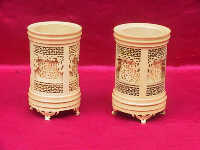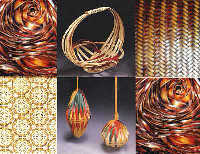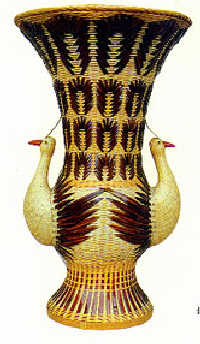 Delicate Process
Delicate Process
 Bamboo basketry is widespread in China and features different local flavors in different places. It is remarkably diverse in terms of technique, form and method of decoration. The techniques range from the delicate and graceful to the rustic and bold.
Bamboo basketry is widespread in China and features different local flavors in different places. It is remarkably diverse in terms of technique, form and method of decoration. The techniques range from the delicate and graceful to the rustic and bold.
Weavers gather and carefully choose bamboo materials in accordance to the following principles:
Maturity: Bamboo aged four to six years is most suitable. Younger bamboo is prone to shrinkage and is often worm-eaten; that over six years, on the other hand, is very mature and cannot be easily broken.
Production area: Bamboo grown in mountains is better due to its softness, tenacity and flexibility from the high humidity in mountains.
Length between nodes: The longer and the flatter, the node rings the better.
Calibers of both ends: The less disparity there is between the two calibers the better.
Color: Bamboo with elegant green and speckle-free stalks is of the best quality.
Once gathered, the materials are cleaned and prepared via various techniques, including cutting, splitting, scraping, dividing, weaving, dyeing, and lacquering. Weavers have to size their materials so that they are uniform in width and diameter -- a meticulous, time-consuming task necessary to ensure the regular and even appearance of the finished craftwork.

 An Art for All
An Art for All
Bamboo basketry is not an art exclusively reserved for women. Younger family members -- male or female -- acquired this skill from their elders by observing, copying and perfecting their skills over many years of practice so they could teach others. The specialized knowledge and skills necessary for gathering and preparing weaving materials is an essential component of Chinese bamboo basketry.
Bamboo weaving is a traditional folk handicraft in Sichuan, Fujian, Zhejiang, Anhui, Taiwan and many other places in China where bamboo is abundant.
Bamboo basketry in ethnic minority areas is known in China as a unique branch of bamboo art. For instance, the She ethnic minorityis famous for its bamboo hats with colorful and delicate designs; theTu ethnic minorityis best known for its artisticcalligraphyon woven crafts; theDaipeople favor exquisitely plaited little bamboo baskets, which serve not only as an ornament around the waist, but also a love promise the Dai boys send to their lovers; theBouyeipeople make white-and-black, two-layered bamboo hats of high artistic value; and theDongpeople make leak-proof bamboo-plaited mess tins.
 A Green Art
A Green Art
 Hand-woven bamboo articles are favored by many people due to the high-level technique involved and fine designs produced. Simple and elegant woven products can infuse a room with an artistic, natural atmosphere. The craftworks have hard outer skins and are odorless and tasteless, thus reducing pollutants from modern furniture ornaments obtained via chemosynthesis.
Hand-woven bamboo articles are favored by many people due to the high-level technique involved and fine designs produced. Simple and elegant woven products can infuse a room with an artistic, natural atmosphere. The craftworks have hard outer skins and are odorless and tasteless, thus reducing pollutants from modern furniture ornaments obtained via chemosynthesis.
Bamboo is widespread and grows rapidly. Since only four-year-old or older bamboo can be used, using bamboo as one kind of material instead of wood is environmentally friendly and good to the sustainable development of rain forest.
Bamboo, as a multi-purpose product for the global marketplace that is easily grown and fashioned into salable merchandise, is what makes the art of bamboo basketry so popular.
